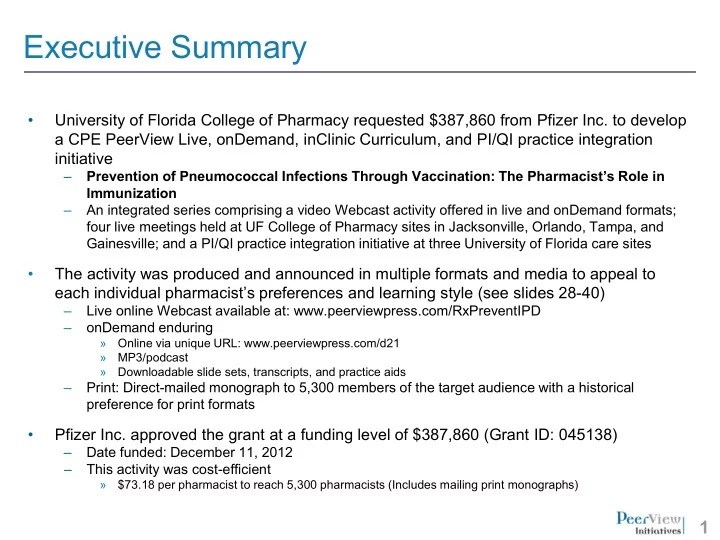

Executive Summary • University of Florida College of Pharmacy requested $387,860 from Pfizer Inc. to develop a CPE PeerView Live, onDemand, inClinic Curriculum, and PI/QI practice integration initiative – Prevention of Pneumococcal Infections Through Vaccination: The Pharmacist’s Role in Immunization – An integrated series comprising a video Webcast activity offered in live and onDemand formats; four live meetings held at UF College of Pharmacy sites in Jacksonville, Orlando, Tampa, and Gainesville; and a PI/QI practice integration initiative at three University of Florida care sites • The activity was produced and announced in multiple formats and media to appeal to each individual pharmacist’s preferences and learning style (see slides 28-40) – Live online Webcast available at: www.peerviewpress.com/RxPreventIPD – onDemand enduring » Online via unique URL: www.peerviewpress.com/d21 » MP3/podcast » Downloadable slide sets, transcripts, and practice aids – Print: Direct-mailed monograph to 5,300 members of the target audience with a historical preference for print formats • Pfizer Inc. approved the grant at a funding level of $387,860 (Grant ID: 045138) – Date funded: December 11, 2012 – This activity was cost-efficient » $73.18 per pharmacist to reach 5,300 pharmacists (Includes mailing print monographs) 1
Executive Summary • Educational Objectives Describe the clinical implications of pneumococcal disease in adults Identify risk factors for pneumococcal disease in adults Employ current guidelines for immunization and reimmunization against pneumococcal disease in adults Identify and overcome barriers that contribute to low pneumococcal vaccination rates in adult patients Discuss the efficacy and safety of available pneumococcal vaccines for adults Increase pneumococcal vaccination rates in appropriate patients based on improvement as an educator, facilitator, and immunizer • Outcomes Level 1 – Participation • Live webcast, onDemand, and inClinic » 2,023 total professionals participated in the activity through the live meetings, online and/or print formats (excludes additional podcast participants accessing solely via iTunes) - Total participant breakdown 1,890 validated, US-based pharmacists 18 validated, US-based community pharmacists 45 validated, US-based hospital-based pharmacists 4 validated, US-based general practitioners 14 validated, US-based MDs 10 validated, US-based other MDs/HCPs 42 other Ex-US other MDs/HCPs » 1,137 activity material downloads (slides, transcripts, practice aids, podcasts, etc.) 2
University of Florida Performance Improvement Initiative - Summary • The intervention workflow rolled out as follows: » Patient file is flagged during chart review/EMR audit » Upon arrival to next appointment, patient is screened as a candidate for pneumococcal vaccination » Pharmacist directly meets with patient and provides education regarding the importance of pneumococcal vaccination; encouragement to receive the vaccination will also be provided. » Via participation in the live webcast and/or enduring programs, the pharmacist will have all of the practical tools and resources to facilitate pneumococcal vaccination in appropriate patients » Upon receiving patient consent, pharmacist will immediately administer the pneumococcal vaccine • Weekly Practice Meetings revealed workflow barriers that need to be addressed • Student Health Center Student Health is following a workflow that is different from what we originally anticipated. Due to workflow considerations, the pharmacist does not directly administer the immunization. Even though the pharmacist is not administering the immunization, he/she is providing (and has been providing since we launched the project) direct counseling to patients at risk and describing why they need the immunization based upon their health status. Once the direct counseling takes place, the pharmacist guides the patient to see a nurse in the practice who can administer the immunization. The pharmacists are seeing the patients first, and they are using a “bookmark” to notify the nurses when the patient has been counseled and would like to receive the immunization. • UF & Shands Family Medicine at Main The pharmacist does not typically come into contact with patients. The pharmacist at that location is responsible for pharmacy student education and oversees all of the pharmacy residents in their work within the practice. The pharmacist created a brief patient education piece as well as a provider piece as tools to increase awareness of the importance of vaccination. 3
University of Florida Performance Improvement Initiative - Summary • UF Shands Eastside Community Practice The pharmacist does see patients and is able to provide counseling on the importance of the pneumococcal (and other) immunizations. However, the pharmacist advises the patient to receive the immunizations, records it in the chart, and sends the patient to the nursing group administer the immunizations. The solution was to ‘flag’ patients who are eligible for the vaccine. The pharmacist at Eastside to counsel the patient and send them on to receive the vaccine. At all sites, the nurses are the ones who administer the immunization. The pharmacists can provide some expertise through counseling, patient education materials, and steering patients to the nurse for the immunization. Though the individual technically administering the immunization at the sites is different than what we originally had contemplated, the pharmacist is able to intervene at each of the sites to achieve the goal: immunize appropriate patients. 4
Level 5 Outcomes – Quality Improvement Initiative Patients Aged 65+ Receiving Pneumococcal Vaccinations at the University of Florida Main Street and Eastside Clinics Vaccination Data Set Patients Vaccinated Rate (%) 2013 - Baseline 900 378 42 2014 - Entire Year 1949 994 51 A 21.4% statistically significant percent increase in vaccination rate pre to post was observed ( χ² p<0.05) Adjustments in the workflow process and the addition of patient and provider educational materials resulted in a marked increase in vaccination rates. 5
Recommend
More recommend